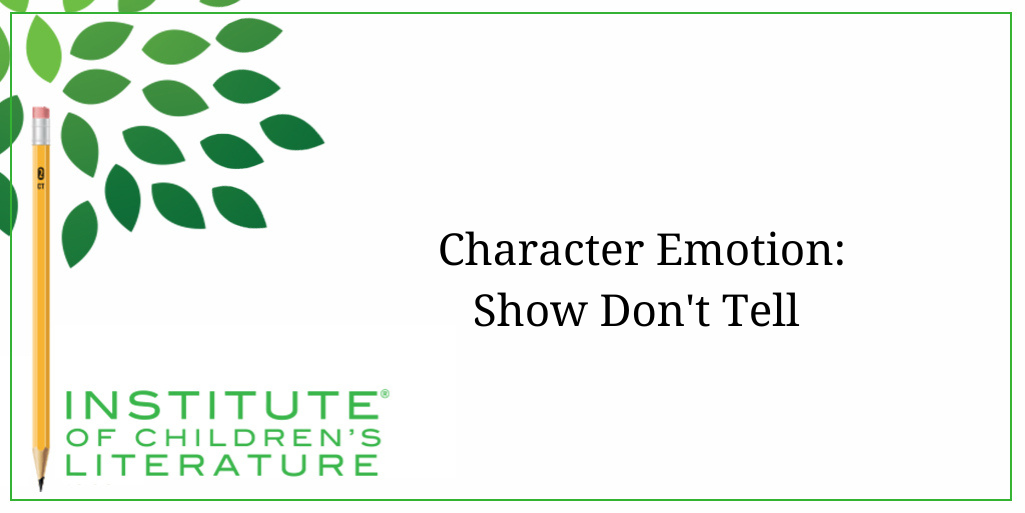
- Date: July 24, 2025
- Author: Jan Fields
- Category: Writing for Children Blog
- Tags: character, character emotion, show don't tell
We teach our students how to write and get published!
View our Course Catalog >
Character Emotion: Show Don't Tell
Emotion is at the core of every element of fiction writing. Plot without emotion is a flat series of actions toward a goal without much meaning or value. Character without emotion lacks believability and connections for the reader. That's why even stories that have “emotionless” machines as characters always end up proving that even robots feel things. At least they do in stories. 
Emotion in the story becomes an instigator of emotion in the reader. And we very much want readers to feel things. Even nonfiction often depends heavily on readers feeling things. Narrative nonfiction in particular is often heavily dependent on emotion, the emotion happening in the narration and the emotion evoked in readers. Because emotion is so important to successful writing, writers need to think about it. And never is this truer than in creating and inhabiting our characters.
Emotional Check-ins
One of my favorite book series is the Murderbot novels by Martha Wells. These aren't books written for children, but they are an interesting case study about emotion. Murderbot is adamant that he isn't a construct with emotions. The most emotion he'll ever admit in himself is annoyance, but the story is full of emotion. Murderbot cares about the people he is meant to protect. Murderbot has feelings about the system in which he lives, and the way he's treated. Readers are acutely aware that what Murderbot says (namely that he doesn't have annoying, ridiculous human emotions) isn't always true. He does feel things. He has emotions that he won't or can't admit to. For this to work, one thing absolutely must be true: the writer must know what Murderbot is feeling, even though the character won't be aware and won't admit to it.
Part of character creation is understanding a character emotionally. This includes big, generally true emotional reactions, such as “this character is easily annoyed” or “this character is timid with strangers.” It also includes very moment specific emotions. What does this character feel in this moment? Understanding what a character is feeling will help in choosing what the character does, because the bulk of our choices come out of our emotional reactions. Knowing what a character is feeling must inform what they do. This helps avoid needing to tell readers what emotions are in play.
Show Don't Tell
Why do we want to avoid telling our readers what characters are feeling? Certainly, it feels efficient to simply say, “George was furious, and that meant Melody was scared.” That kind of emotional announcement seems like a good choice. After all, once readers are informed of the emotions in play they can then interpret everything that comes next through the knowledge of what everyone is feeling. The problem with emotional telling is that it doesn't provoke emotion in the reader. When you read the words “Kat was annoyed,” you don't feel annoyed on her behalf. It's simply information. But we want more than that from our readers. We want them to feel things.
 If announcing the emotions of our characters doesn't provoke reader emotions, what should we do instead? The answer is in our character's actions, choices, and dialogue. We don't tell the emotion. Instead, we let the reader observe the emotion. And that only works if we portray the emotion and do it in an engaging and believable way.
If announcing the emotions of our characters doesn't provoke reader emotions, what should we do instead? The answer is in our character's actions, choices, and dialogue. We don't tell the emotion. Instead, we let the reader observe the emotion. And that only works if we portray the emotion and do it in an engaging and believable way.
For Example…
Notice how the following exchange never once tells you what the characters are feeling. It tells us what the characters do. It reveals what the characters say. But the interpretation is up to you. What do you think they are feeling? Which character's emotions are clearer?
Paul tugged on Cilly's hand. “I need you to come with me. Now.
Cilly frowned and tried to pull her hand free. “I don't have time for this.”
Paul tightened his grasp. “You don't understand,” Paul said. “You need to trust me.”
She jerked her hand away, even as she stepped closer until her face blurred in his vision. “I need to trust you? Are you kidding me? Me trust you? After all you've done.”
“We don't have time. Please, Cilly. Please, come with me.”
It is Okay to be Mysterious
Readers are more engaged by fiction if it requires some thinking. In the above brief exchange, we don't know why Paul wants Cilly to go with him. We don't know what he has done in the past that left Cilly distrustful towards him. We don't have to know these things for the exchange to make sense, because we understand the essential basics: Paul wants Cilly to go with him. Potentially he even needs her to go with him. Cilly doesn't trust him and has a fair bit of anger towards him. That becomes enough to make the exchange work. Being informed of everything is less engaging than leaving the reader with something to think about, something to figure out. 
Now, if we continued with Paul and Cilly, the reader is going to eventually need to know why Paul is so desperate to get Cilly to come with him. That is going to be a bit of mystery that will have to be solved for the reader to feel satisfied with the story. We won't necessarily need to know all of this pair's backstory. Sure, the reader will appreciate getting a few more scraps of information about their past, probably sprinkled into dialogue, but that is less essential. Even from that brief scrap above, the reader can see Paul has done something in the past that has wrecked his relationship with Cilly. That may be all we need.
Part of character creation is sorting out what the reader will need to know for the story to be emotionally successful. That is not equal to what the writer needs to know. The writer needs to know everything. The reader only needs to know enough to make the story engaging and emotionally true. You may choose to let the reader know more than that but know that there is some danger in this. Too much information slows plot and dulls engagement. A little mystery keeps things interesting and keeps readers engaged.
Feel It
I hope I've convinced you of the importance of paying attention to emotion as you build your characters, and that you'll reveal those emotions through action, dialogue and (sparingly) inner thoughts. Make the reader work for it. Make them want to understand what is going on with your characters. Get the reader involved, and you'll have them emotionally connected throughout your story and beyond. And that is a very good thing indeed!
Related Articles for Character Emotion
With over 100 books in publication, Jan Fields writes both chapter books for children and mystery novels for adults. She’s also known for a variety of experiences teaching writing, from one session SCBWI events to lengthier Highlights Foundation workshops to these blog posts for the Institute of Children’s Literature. As a former ICL instructor, Jan enjoys equipping writers for success in whatever way she can.




